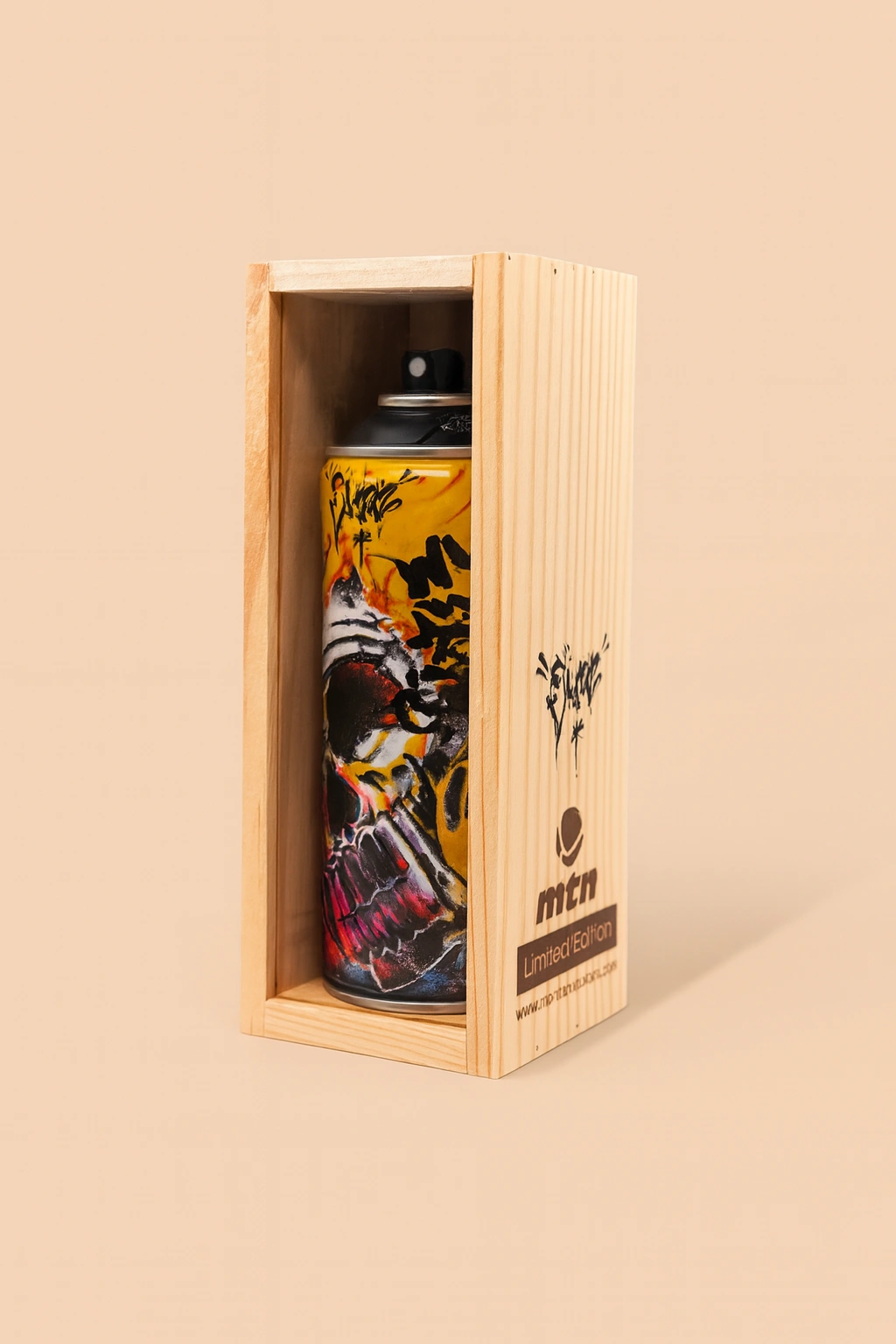A rare object returns: hand-made, battle-scarred, and encoded with myth. The Barshaw Gangstarr V1 is RAMMELLZEE’s vision in vinyl.
RAMMELLZEE didn’t make art. He forged weapons.
To call the Barshaw Gangstarr Figure V1 a collectible misses the point entirely. This isn’t just a vinyl sculpture or a posthumous reissue. It’s a manifestation of RAMMELLZEE’s full-blown cosmology—one where graffiti was galactic warfare, language was the enemy, and found objects were tools of resistance. Now, in 2025, Garageworks Industries has pulled this singular figure from the archives and re-released it in a razor-tight run of 100. This is no nostalgia drop. It’s a call to arms.
Originally released in 2021 in an edition of 300, the Barshaw Gangstarr V1 instantly became a grail among art collectors and culture heads alike. Not just because it was rare. Not just because it included a cassette tape with tracks by the late icon himself. But because it did something few toys—or sculptures, for that matter—ever manage: it captured chaos.
The Artist as Myth: Who Was RAMMELLZEE?
To understand the figure, you have to understand the figurehead.
Born in Far Rockaway, Queens, RAMMELLZEE was a graffiti bomber turned philosopher, a hip-hop MC turned street alchemist. He was a foundational figure in the early ‘80s downtown New York art scene, showing alongside Basquiat and Keith Haring but never reduced to a single movement. His philosophy—known as Gothic Futurism—centered around “the battle of letters.” To him, language was a control system. Writing on walls was rebellion. Masking the self was resistance.
RAMMELLZEE built costumes that looked like space-age samurai armor, assembled from garbage, plexiglass, and metal scraps. He recorded anarchic music that blurred genres, layered with distortion and coded language. He wrote manifestos about the militarization of style.
And crucially, he sculpted.
Barshaw Gangstarr V1: From Hand to Form
The Barshaw Gangstarr Figure V1 is modeled directly from RAMMELLZEE’s own hand-sculpted resin prototype, made in the early 2000s. Every detail—from the asymmetrical armor to the weathered finish—is guided by his original instructions. It isn’t a tribute. It’s an extension.
Garageworks Industries, the label behind the limited release, worked with RAMMELLZEE’s estate to bring the figure to life, staying true to his exacting process. The figure stands 12 inches (30.48 cm) tall and is painted using techniques described in RAMMELLZEE’s own notes and tutorials. Each one is hand-detailed. No two are alike.
But what sets V1 apart is what it’s made from.
In keeping with RAMMELLZEE’s method of using “weaponized found objects,” the figure comes with accessories made from recycled and discovered materials—bits of metal, plastic, fabric, even screws and wires. These aren’t just props. They’re signatures. They transform each figure into a one-of-one sculpture that exists between art, relic, and riot.
Opened Bag, Closed Loop
Unlike most collectibles, the Barshaw Gangstarr doesn’t come shrink-wrapped or sealed in a box. It ships in an “opened bag,” deliberately unpolished. That choice is a message: this isn’t a pristine commodity. It’s a post-industrial icon. It comes battle-worn, because it’s meant for war.
The open packaging is also a nod to RAMMELLZEE’s disdain for consumer predictability. He famously hated gloss. His sculptures weren’t meant to be displayed under perfect lighting but handled, interacted with, even played with—though “play” in his world was a weaponized act of defiance.
The Cassette: Analog as Archive
Each figure includes an exclusive cassette tape recording of RAMMELLZEE. That detail alone makes the figure a double artifact—part sculpture, part sound archive.
The cassette is more than a novelty. It’s a sonic time capsule, giving collectors access to RAMMELLZEE’s voice, his thoughts, and his sound experiments. Whether it’s distorted rhymes, fractured theory, or pure noise, the tape transforms the collectible into a multimedia encounter. Vinyl meets magnetic tape. Sculpture meets sound. Future meets residue.
And yes, it’s analog. Because RAMMELLZEE believed in friction. In imperfection. The crackle of tape. The hiss of a recording made too loud, too fast, too raw.
Limited Run, Infinite Signal
The current reissue is limited to 100 figures, making it even rarer than the original 2021 drop of 300. This isn’t artificial scarcity—it’s part of the design logic. RAMMELLZEE’s work wasn’t built for mass production. His sculptures were complex, layered, and deliberately unstable. Trying to “scale” them would miss the point.
Each piece carries a different weight. A slightly different color scheme. Different scarring. Different story.
Owning one means owning part of the myth. But more than that, it means carrying a fragment of RAMMELLZEE’s weaponized imagination into the present.
V2: The Other Side of the War
For serious collectors, there’s also the Barshaw Gangstarr Figure V2—a companion piece with a different build, different accessories, and a different sonic payload. While V1 embodies a more primal, raw aesthetic, V2 skews sharper, more angular, with references to RAMMELLZEE’s later armor designs and “Garbage Gods” theory.
Together, V1 and V2 represent a dialectic. Form and anti-form. History and mutation. If V1 is a field weapon, V2 is a philosophical upgrade. Garageworks offers the two separately but encourages collectors to own both—because RAMMELLZEE never made standalone ideas. Everything was part of a larger system.
Legacy in 3D
RAMMELLZEE passed in 2010. But like all great culture-shifters, he never really left. His work has been featured in major museum shows (MoMA PS1, Red Bull Arts, Jeffrey Deitch), his theories published in limited-run zines, and his influence felt in everything from Afrofuturism to cyberpunk aesthetics to rap fashion.
But the Barshaw Gangstarr figure does something rare: it brings his ideas into three dimensions that you can hold, turn, examine, and decode. It takes the abstract and gives it physicality. It’s the closest you can get to holding one of his theories in your hand.
Art vs. Collectible: Who Says You Have to Choose?
There will always be tension around calling something like this a “toy.” For collectors, it’s sculpture. For critics, it’s material culture. For fans, it’s both—and that’s the point.
The figure sits at the intersection of gallery art, hip-hop memorabilia, street culture, and experimental design. It doesn’t play by the rules of any one world because RAMMELLZEE didn’t either.
You can shelf it next to a KAWS piece or next to a Basquiat monograph. It holds its own.
Why It Matters Now
In an era where much of art has been flattened into content and collectibles often mean “clean plastic pop,” the Barshaw Gangstarr figure resists polish. It bleeds. It breaks the frame.
It matters now because it refuses to be easy. It matters because RAMMELLZEE’s messages about control systems, language warfare, and cultural resistance feel more urgent than ever. And it matters because it doesn’t pander.
There’s no user-friendly onboarding to RAMMELLZEE. You get it, or you don’t. And if you do, this figure isn’t just merch. It’s a relic from the future-past.
Impression
The Barshaw Gangstarr Figure V1 is more than rare. It’s resonant.
It carries with it RAMMELLZEE’s voice, his method, his rejection of categories. It’s handmade, hand-finished, and made with the kind of care that spits in the face of industrial sameness. It arrives not polished, but alive.
Whether you’re a scholar of street art, a student of hip-hop history, or a collector who’s been chasing one since 2021, this reissue is more than worth the hunt. It’s not just an object. It’s a signal.
And in the world of RAMMELLZEE, signals are everything.
No comments yet.









